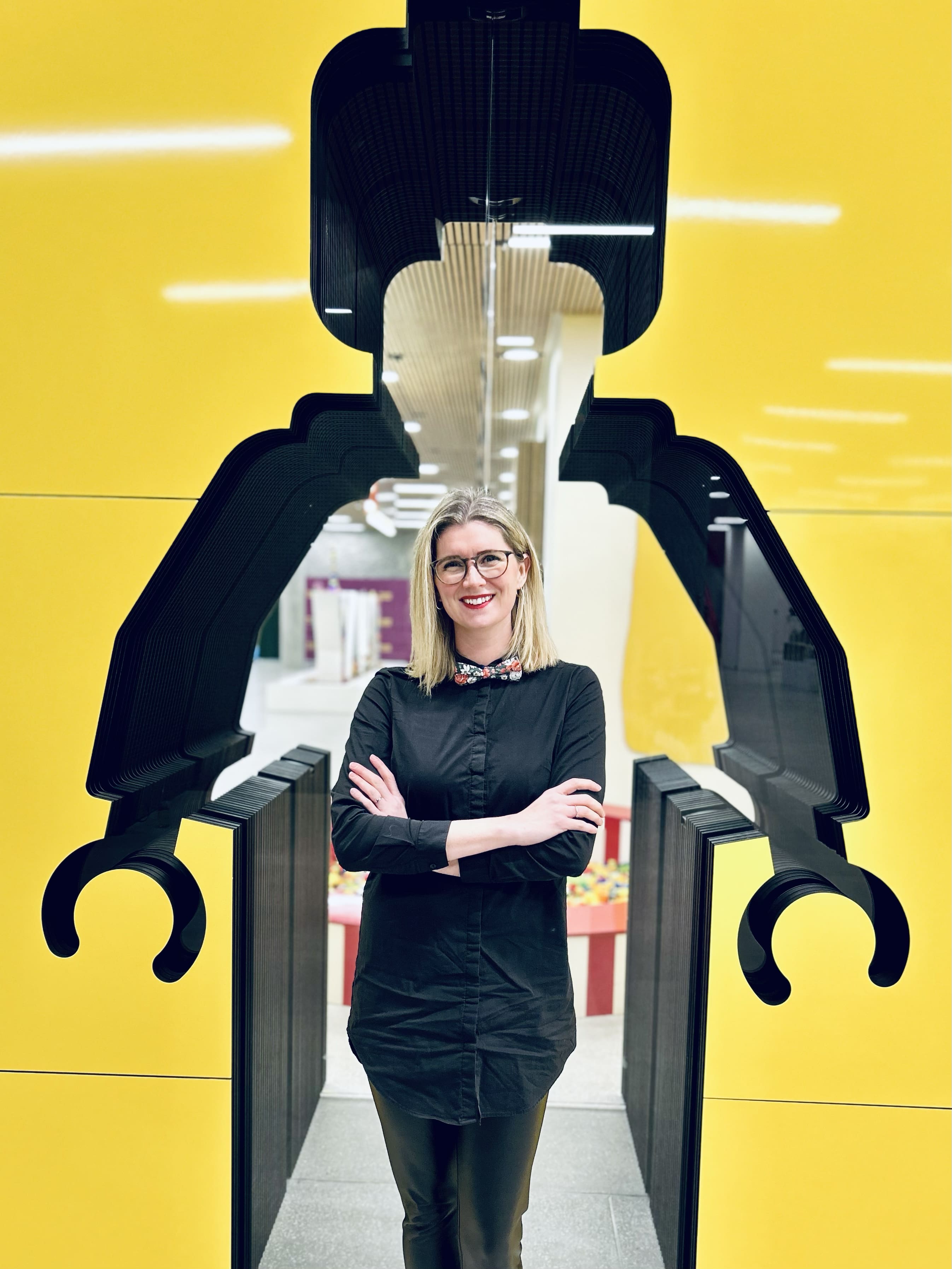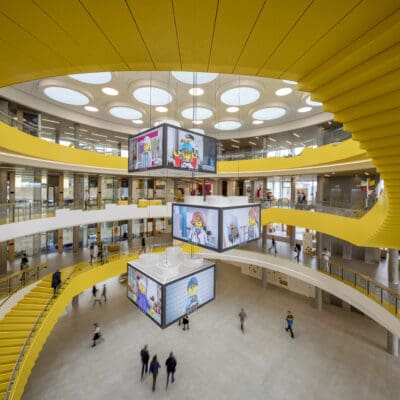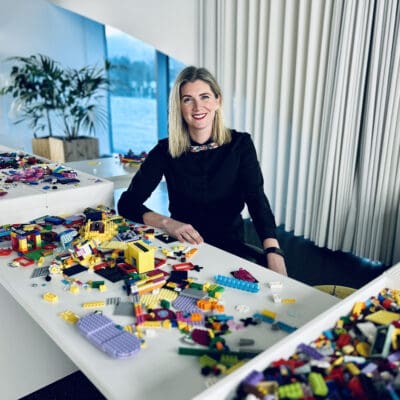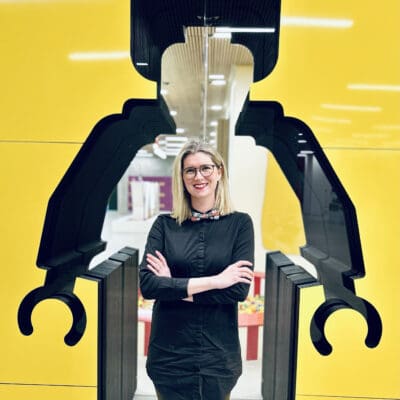From Detroit to Denmark: CCS prepared Graphic Design alum to stand tall as senior design manager at The LEGO® Group
February 19, 2024
People who say that the journey is more important than the destination haven’t met Megan Shellenbarger (Graphic Design ’09).
She’s managed to make the most out of both.
“CCS prepared me for the world more than I ever knew,” Shellenbarger said. “The bar was so high, and the knowledge base was so broad, that I felt like I really was set up to graduate and stand on my own two legs.”
Currently, that would be in Denmark, where she’s a senior design manager at The LEGO Group.
But before venturing across the Atlantic Ocean, Shellenbarger moved to Phoenix with her then-boyfriend and fellow College for Creative Studies alum. “Once I graduated, I was convinced, ‘I’m done with snow, I’m done with the north, I’m going somewhere warm.’”
She’d settled into a job designing software for a company offering online learning for high school students when she saw that The LEGO Group was recruiting for digital art directors. Her dad encouraged her to take a leap, telling her: “You don’t have a house, you don’t have kids. You’re young. If you’re going to try something, go now. Worst case scenario you go over and you don’t like it, then you come home, and if you do, you stay.”
The LEGO Group’s digital organization has over 1,800 digital colleagues and more than 120 digital designers, and is spread out across four locations: Billund, Copenhagen, London and Shanghai. Shellenbarger is situated at The LEGO Group’s new campus in the town of Billund, where the family-owned company was founded in 1932.
Starting out as a contract designer, Shellenbarger worked on mobile apps, web design and other digital user interface (UI) experiences. Thirteen years later, she leads a 16-member team across multiple product areas as part of the organization that supports what most people think of when they hear the word “LEGO®” — children playing with plastic bricks.
“Our area develops consumer-facing experiences, which are intended to be engagement experiences that provide added play value to our physical toys,” she said. “The LEGO Group’s core values of imagination, fun, caring, creativity, learning and quality strive to foster the most out play time for kids, be it with physical or digital play.”
Shellenbarger’s team finds ways to digitally aid and enhance “the core play experience.” For example, they produce a website exclusively for kids where they can learn about their favorite characters and get tips and tricks from master model designers.
“It’s about creating these digital touch points that can make the physical play experience a bit richer or more personalized,” she said.
Although LEGO bricks seem like the perfect non-screen time play, Shellenbarger explained that digital experiences can aid the building experience, particularly with young children.
“We had an observation in user testing that found some young builders were ignoring the left page in our building instructions,” she said. “In our building instructions, the left page contains important information — get this brick — and the right can be where you see the really cool model that you’re supposed to put the brick on. This resulted in kids sometimes missing the bricks they were supposed to use or steps in the building process because they were concentrating on the right page.”
That’s where the screen comes in, Shellenbarger said. “Starting with user problems is where we as digital creatives can experiment with technology to find new solutions. Today, we have an app called LEGO® Builder, where we can enable a special mode within our 3D building instructions that breaks the left and right page experience down for young builders into two steps, find the bricks, place the bricks, ‘OK, find these.’ They hit the next button, and then they can see on the screen where to place them on the model. If they’re in doubt, they can zoom in and rotate the model for a better view.”
Although Shellenbarger may not be as digitally native as the children she works to help entertain through The LEGO Group, she showed a strong inclination in high school, where she learned computer-aided design and Adobe Photoshop and Illustrator through Lynda tutorials (now LinkedIn Learning). Recognizing her natural abilities, her art teacher helped her become a member of the Business Professionals of America so she could enter design competitions.
Then, when Shellenbarger’s parents pushed her toward business school, that same art teacher sat them down and told them, “Listen, you need to let your daughter pursue this. She’s got a knack for computers and for design. You should really support her going to school for this.”
They relented, and Shellenbarger was accepted to the honors program at Ferris State University, where her stepfather was an adjunct professor. After earning her associate degree in Visual Design and Web Media at Ferris, she decided that a “hardcore art school” was the best next step for her.
“I remember being really motivated by hearing about all of the career opportunities CCS students had, that they were going to work in other states and for big companies,” she said. “When I applied and was accepted, I couldn’t have been more excited.”
And once she arrived on the CCS campus? It was, in a word, “intense.”
“There was a steep learning curve, of course,” Shellenbarger said. “You had to know all the tools really well. You had teachers who didn’t mind pointing at your work on the wall and telling you, ‘This is just not good enough.’ That was a shock to me. I think I had been quite coddled up until that point.”
She also found herself challenged in ways she’d never been before — like for a project in a class co-created by Susan LaPorte (DGD 412), the project was around social sustainability, where she and a classmate observed and searched the streets of Detroit for items that “represented isolation.” They collected an assortment of tires, chairs and other abandoned things, spray-painted them neon yellow and then hosted an installation in front of the historic Highland Park Ford Plant to invite people to meet and engage in an otherwise isolated space.
In the end, she and her partner returned the objects to where they’d been found. “They all disappeared within a week,” Shellenbarger said.
Although her career at The LEGO Group involves far less spray paint, Shellenbarger still leans into much of what she learned at CCS, especially the ability to work with others and pool the hive mind, speak about a design in an informed way, and give and receive feedback.
“That’s not a skillset everybody comes with,” she said. “Working in the digital product design industry, I’m not making art pieces anymore. I do make beautiful things, but they serve a concrete purpose, and they have a customer at the end of the day, so you need to be able to let go of some things and accept that, sometimes, you must go against even what feels right. CCS gave me a bit of grit and robustness that prepared me for that.”
Also, the multitude of classes and briefs she worked on as a student prepared her for the opposite end of the spectrum — to just “run with it” at times and trust her instincts. Reactive change is a learned behavior, she noted, and many creatives are more used to spending time with their ideas and investing in their thoughts and visions.
“Life is often one of circumstance — who you meet and how you react,” said Shellenbarger, who now has a Danish partner and is raising a family in her adopted homeland. “In my experience, it’s some of the best in class, most talented individuals. I definitely have CCS to thank for being where I am today.”



